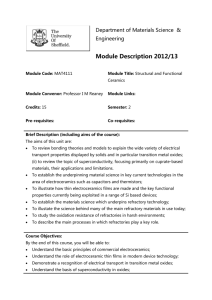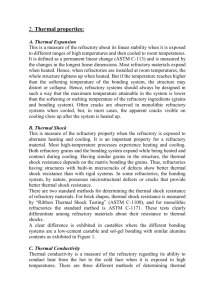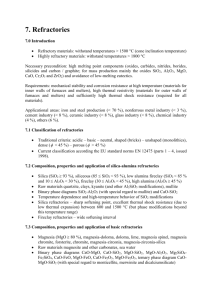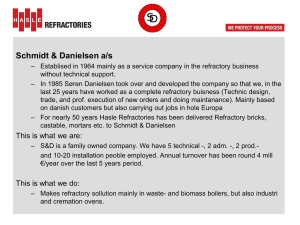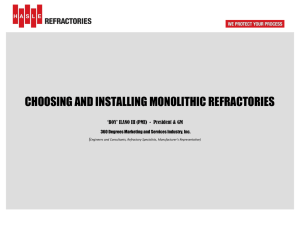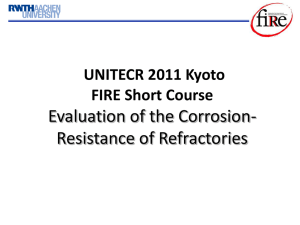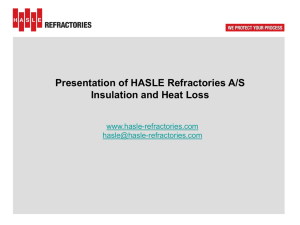Properties of refractories: Refractory properties can be classified as
advertisement
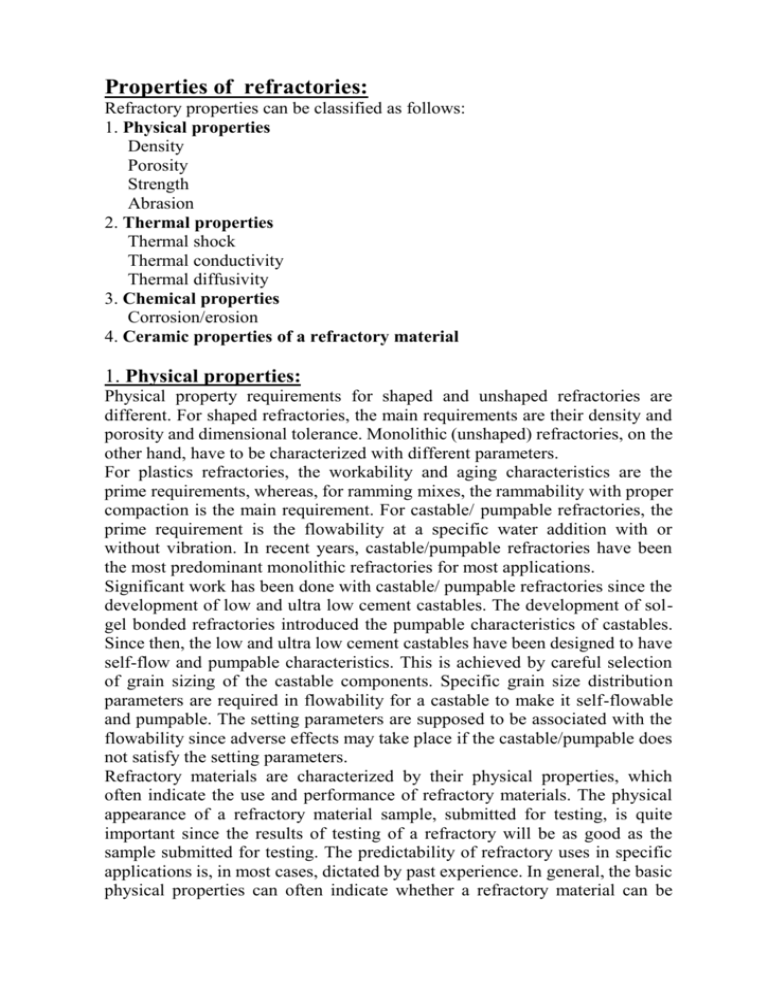
Properties of refractories: Refractory properties can be classified as follows: 1. Physical properties Density Porosity Strength Abrasion 2. Thermal properties Thermal shock Thermal conductivity Thermal diffusivity 3. Chemical properties Corrosion/erosion 4. Ceramic properties of a refractory material 1. Physical properties: Physical property requirements for shaped and unshaped refractories are different. For shaped refractories, the main requirements are their density and porosity and dimensional tolerance. Monolithic (unshaped) refractories, on the other hand, have to be characterized with different parameters. For plastics refractories, the workability and aging characteristics are the prime requirements, whereas, for ramming mixes, the rammability with proper compaction is the main requirement. For castable/ pumpable refractories, the prime requirement is the flowability at a specific water addition with or without vibration. In recent years, castable/pumpable refractories have been the most predominant monolithic refractories for most applications. Significant work has been done with castable/ pumpable refractories since the development of low and ultra low cement castables. The development of solgel bonded refractories introduced the pumpable characteristics of castables. Since then, the low and ultra low cement castables have been designed to have self-flow and pumpable characteristics. This is achieved by careful selection of grain sizing of the castable components. Specific grain size distribution parameters are required in flowability for a castable to make it self-flowable and pumpable. The setting parameters are supposed to be associated with the flowability since adverse effects may take place if the castable/pumpable does not satisfy the setting parameters. Refractory materials are characterized by their physical properties, which often indicate the use and performance of refractory materials. The physical appearance of a refractory material sample, submitted for testing, is quite important since the results of testing of a refractory will be as good as the sample submitted for testing. The predictability of refractory uses in specific applications is, in most cases, dictated by past experience. In general, the basic physical properties can often indicate whether a refractory material can be used for intended applications. The following basic physical properties are often used to predict, select, and prescribe refractories for specific applications: A) Density and porosity B) Strengths - cold and hot C) Abrasion The above properties are determined by standard ASTM tests, and hence the materials are classified and characterized according to their physical test results. The significance and characterization of the above tests can be summarized as follows: A) Density and Porosity (ASTM D-20): The values of density and porosity determined by standard methods are used to recommend or predict the use of refractories for specific uses. In general, the higher the density, the lower the porosity. Also, other physical properties, such as strength, abrasion, and gas permeability, are often related to the density and porosity of the refractory. B) Strengths: Cold and hot, their importance - The physical strengths, in both cold and hot conditions, are often characterized as measures of the use of a refractory. Cold strengths indicate the handling and installation of the refractory, whereas hot strengths indicate how the refractory will perform when used at elevated temperatures. Initial strength develops in refractory materials during the forming process. For shaped refractories, the strengths often develop during the physical processing of the products and sometimes followed by higher temperatures where the refractory goes through a firing process. For monolithic refractories, the initial strength develops during the installation or forming process (for precast shapes), and the final strength develops while in application. In recent years, more importance has been given to high-temperature strengths of refractories rather than cold strengths since refractories are used at elevated temperatures and not at room temperatures. Strengths of refractories are measured as cold compressive strength, cold modulus of rupture, or hot modulus of rupture. Hot modulus of rupture provides the best indication of the performance of a refractory material in use. a) Cold Compressive Strength (ASTM C-133) The cold compressive strength of a refractory material is an indication of its suitability for use of refractories in construction. It is a combined measure of the refractory for the strength of the grains and also of the bonding system. b) Cold Modulus of Rupture (ASTM C-133) The cold modulus of rupture of a refractory material indicates the flexural strength and its suitability for use in construction. It is indicative of the strength of the bonding system of the refractory product. Since the test is done at room temperature, it can only show its suitability and its use in construction. It provides no indication of how the refractory will behave at elevated temperatures. c) Hot Modulus of Rupture (ASTM C-583): The hot modulus of rupture provides the indication of a refractory material about its flexural strength at elevated temperatures. Since refractories are used at elevated temperatures, the hot modulus of rupture is the true indicator of the suitability and performance of a refractory at high temperatures. Hence, in recent years, the hot modulus of rupture has been prescribed and required by users as the most important test criterion for selection and use of refractories. C) Abrasion Resistance (ASTM C-704): The refractory particles and its resistance to the flow of high-velocity particles across its surface. The need for good abrasion resistance of refractory materials is most evident in petrochemical industries where fine particles impinge the refractory surface at high velocities at moderately elevated temperatures. A direct correlation between abrasion resistance and cold crushing strength has recently been established. Thus, the cold crushing strengths can provide, and have a direct indication about, the predictability of a refractory material regarding its resistance to abrasion. 2. Thermal properties: A. Thermal Expansion This is a measure of the refractory about its linear stability when it is exposed to different ranges of high temperatures and then cooled to room temperatures. It is defined as a permanent linear change (ASTM C-113) and is measured by the changes in the longest linear dimensions. Most refractory materials expand when heated. Hence, when refractories are installed at room temperatures, the whole structure tightens up when heated. But if the temperature reaches higher than the softening temperature of the bonding system, the structure may distort or collapse. Hence, refractory systems should always be designed in such a way that the maximum temperature attainable in the system is lower than the softening or melting temperature of the refractory ingredients (grains and bonding system). Often cracks are observed in monolithic refractory systems when cooled, but, in most cases, the apparent cracks visible on cooling close up after the system is heated up. B. Thermal Shock This is measure of the refractory property when the refractory is exposed to alternate heating and cooling. It is an important property for a refractory material. Most high-temperature processes experience heating and cooling. Both refractory grains and the bonding system expand while being heated and contract during cooling. Having similar grains in the structure, the thermal shock resistance depends on the matrix bonding the grains. Thus, refractories having structures with built-in microcracks of defects show better thermal shock resistance than with rigid systems. In some refractories, the bonding system, by nature, possesses microstructural defects or cracks that provide better thermal shock resistance. There are two standard methods for determining the thermal shock resistance of refractory materials. For brick shapes, thermal shock resistance is measured by “Ribbon Thermal Shock Testing” (ASTM C-1100), and for monolithic refractories the standard method is ASTM C-1171. These tests clearly differentiate among refractory materials about their resistance to thermal shocks. A clear difference is exhibited in castables where the different bonding systems are a low-cement castable and sol-gel bonding with similar alumina contents as exhibited in Figure 1. C. Thermal Conductivity Thermal conductivity is a measure of the refractory regarding its ability to conduct heat from the hot to the cold face when it is exposed to high temperatures. There are three different methods of determining thermal conductivity of refractory materials. ASTM C-210 is the standard method for determining Figure 1 Retained strength of low-cement and gel-bond castables with similar alumina contents (grains) as per ASTM C-1171. thermal conductivity of refractories; ASTM C-202 is the standard method for determining thermal conductivity of refractory brick; and ASTM C-1113 is the standard method for determining thermal conductivity of refractories by hot wire. The thermal conductivity tests are particularly important for insulating refractories where the thermal gradients from the hot face to the cold face dictate the use of a refractory material for the specific uses. D. Thermal Diffusivity The thermal diffusivity property is particularly useful for carbon-containing materials. ASTM C-714 is the standard method for determining thermal diffusivity of carbon and graphite by the thermal pulse method.
